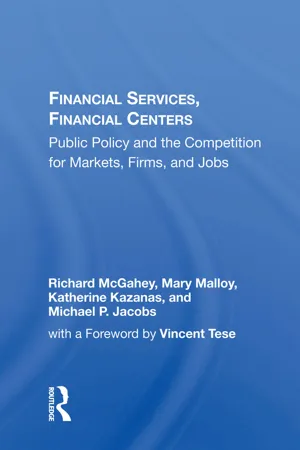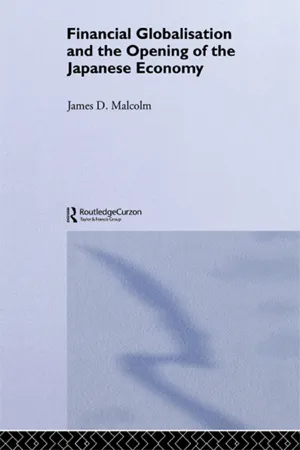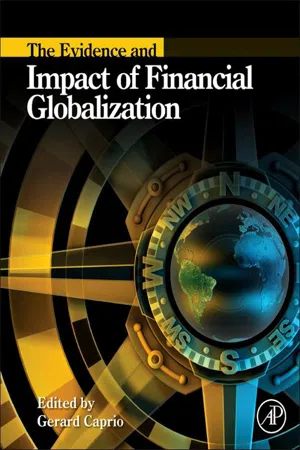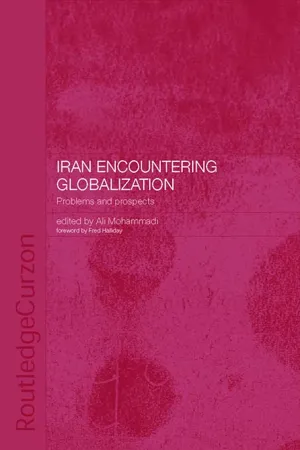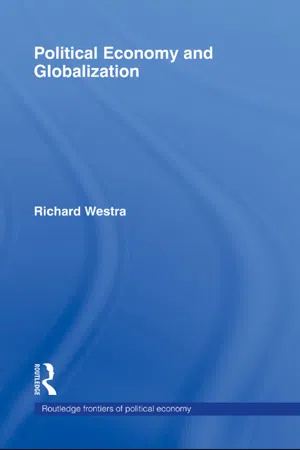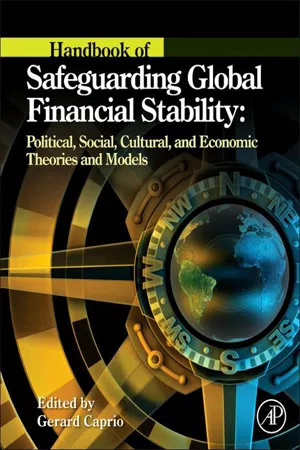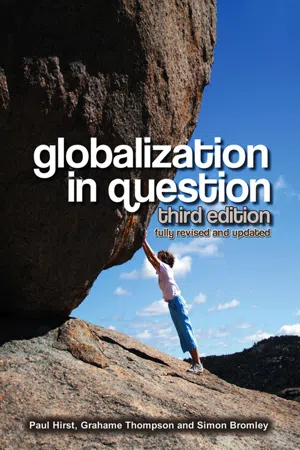Economics
Financial Globalization
Financial globalization refers to the increasing interconnectedness and integration of financial markets and institutions on a global scale. It involves the flow of capital, investments, and financial services across borders, leading to greater international capital mobility and cross-border financial transactions. This phenomenon has been driven by advancements in technology, deregulation, and the liberalization of financial markets.
Written by Perlego with AI-assistance
Related key terms
12 Key excerpts on "Financial Globalization"
- eBook - ePub
- Grahame Thompson(Author)
- 2014(Publication Date)
- Routledge(Publisher)
et al . 2009: Chapter 6). The rest of this section provides evidence for this and suggests that there is no truly ‘globalized’ financial system, despite recent events that seem to have confirmed that the crisis took a quintessentially global form. The apparent paradox of there being no truly global financial system at the same time as there seems to have been a global crisis and slowdown, will be addressed in a later section.Subsequently the chapter develops an alternative assessment and explores some of its consequences. This is important because unless the key characteristics of the international financial system are fully recognized it is difficult to suggest sensible measures that might be employed to address its shortcomings and deal with its failings.A key element in this assessment relates to the way conventional economics goes about analysing the international economic system and globalization. Although there are many alternative specifications and nuances, the basic approach continues to be one that models global economic welfare in a perfectly competitive world (though there are models of the kind considered in a moment that work with oligopoly). As the above outline of Financial Globalization indicates, many presumptions that are controversial and unrealistic would need to be built into such a modelling environment. Nevertheless, such a modelling framework continues to drive the conventional understanding of the financial system as it operates in an international context. One of the specific approaches is to develop a computable general equilibrium model (or C-GEM), the characteristics of which can be used to illustrate many of the difficulties and misunderstandings associated with globalization as it is conventionally understood.1 Although such C-GEMs are too mathematically sophisticated and complex to be fully considered here, at their heart is an expression such as the one shown in square brackets in equation (1) - eBook - ePub
- Rob Dransfield(Author)
- 2013(Publication Date)
- Routledge(Publisher)
This chapter introduces one of the most important aspects of the modern macro-economy, the nature of globalization. Business operates in an external environment in which economic forces are particularly significant. Key economic drivers of globalization have been the growth of international markets and the expansion of international trade. The growth of the global economy has been supported by the spread of free market economics across the globe which has encouraged specialization and trade. The development of international means of exchange (i.e. reserve trading currencies such as the dollar) and the influence of international bodies such as the World Trade Organization (WTO) have enabled a process of globalization.However, the concept of ‘globalization’ (whatever it signifies) is by no means universally accepted as a good thing and for some the recent financial crisis is seen as a symbol of the wider crisis of globalization. This chapter also looks at different forms of protectionism, which is one approach that countries take to defend their home markets against more aggressive international competitors. The chapter concludes by defining and describing foreign direct investment (FDI) and looks at some of the ways that business organizations can enter new markets.12.2 What is globalization?No economics text would be complete without a chapter on the economics of globalization. Recent economic events have increased our awareness that all of us are dependent upon or impacted by what is happening in the global economy. It is not just car workers in France, or construction workers in Poland, that have felt the impact of the financial crisis but also taxi drivers in Greece and bankers in London.In 2012, most people were aware that there has been a rapid slowdown in the growth of economic activity not just in Europe and the United States but in emerging economies, particularly India and China. Globalization is often cited as one of the major culprits for the financial crisis.Key Theme The crisis of globalizationRobert Skidelsky (2010) argues that the ‘financial crisis’ was fundamentally a crisis of globalization and the thought processes that underpinned it. Skidelsky identifies three kinds of failure that led to the financial crisis:- Institutional – ‘banks mutated from utilities into casinos’. Skidelsky argues that regulators and policy-makers had come to believe in an ‘efficient market theory’ – a view that financial markets would not consistently mis-price financial assets and therefore needed little regulation. In the event what actually happened was that many assets were overpriced for a substantial period of time.
- eBook - ePub
Financial Services, Financial Centers
Public Policy And The Competition For Markets, Firms, And Jobs
- Richard McGahey(Author)
- 2019(Publication Date)
- Routledge(Publisher)
4 Globalization of FinanceIn recent years, references to the "globalization" of finance have become something of a cliche in the financial press. Yet globalization is a continuing transformation of major proportions and a significant part of the new competitive environment in financial services.The transformation of financing activities from segregated national debt and equity markets to a truly international capital market operating 24 hours a day is fostering continuing and growing international competition at home and abroad. U.S. financial firms are expanding to pursue opportunities abroad, establishing facilities and market presence in all parts of the world, particularly in London and Tokyo. In turn, foreign banks and securities firms, attracted by the size and stability of U.S. financial markets, are building a major cross-border presence to help satisfy their clients ' growing appetite for international borrowing and investing. The competitive pressure on financial services firms to establish and maintain such a presence has promoted the emergence of new financial centers and redefined the role of more established ones.This chapter outlines the dramatic changes that go by the name globalization. It goes on to discuss how these changes have occurred historically and what they mean for the competitive environment among firms. Finally, it examines how these changes are affecting the location of financial activity, with special attention to the three main global centers — London, Tokyo, and New York.Globalization is shorthand for the continuing international integration of the world's national financial markets. Financial markets around the world have become linked as never before into a single global pool of funds, accessible by customers and investors from all around the world, especially from the industrialized countries. Suppliers and demanders of capital no longer need to be in the same location in order to invest or borrow. Increasingly, investors are diversifying their portfolios across national boundaries. Corporations shop around the world for funds at the lowest cost. And investors engage in ever-more sophisticated transactions that present greater profit opportunities, or that meet special needs for diversification and risk management. - eBook - ePub
- Bertelsmann Foundation (ed.)(Author)
- 2012(Publication Date)
- Bertelsmann Stiftung(Publisher)
Economic GlobalizationScott Barrett1 Introduction
The world’s economic system consists of different markets: markets in goods, services and labor linked through trade; markets for capital, to spread risks and fund investment, linked by financial integration; and markets for innovation linked by a system of intellectual property rights. If we take a broader definition, economic globalization can encompass standards, knowledge, human migration, infectious diseases and greenhouse gas emissions. In these last cases especially, markets may be missing or grossly imperfect, but their international consequences are still relevant to human well-being. Moreover, these imperfect markets are integrally connected to the more conventional ones. For both reasons, they should be incorporated in our analysis.In this paper, I develop a perspective on economic globalization – explaining what it is, why it can threaten and also enhance progress in human development, and how it evolves over time. I shall not make predictions but, rather, provide a framework for thinking about globalization’s future.2 The Current State of Economic Globalization
Globalization is the process of ever-closer interconnectedness. It is a process that promises rewards, challenges traditions and creates new risks. It is, above all else, a process that evolves. By “evolution” I mean directional change. Both the direction and rate of change of globalization are shaped by national and international institutions.Since globalization is an evolutionary process, its current state is a product of its history. My discussion thus begins by interweaving the past and the present. Though “globalization” can sometimes refer to trends in culture, politics, biodiversity and technology, in this paper, I have used the term to describe economic globalization, in particular. - eBook - ePub
From Walmart to Al Qaeda
An Interdisciplinary Approach to Globalization
- David Murillo(Author)
- 2017(Publication Date)
- Routledge(Publisher)
4 Financial Globalization If globalization has become a synonym for capitalism to the extent that globalization is converted into a province of the world economy, in recent decades the economy itself must be seen as a province of capital flows and the global financial system. The key concept that accounts for this alteration is that of financialization: the profound transformation of economic structures through the progressive deployment of an increasingly autonomous, globalized and deregulated financial system. We must therefore conduct an in-depth examination of this concept of financialization and its scope. We will also need to understand the economic changes associated with financialization and its impact on social and political structures, and we must do so without losing sight of the current crisis and its relationship with the expansion of the global financial system. 4.1 Macroeconomic imbalances and financial imbalances Economics provides a quite descriptive account of the relationship between the theoretical construct we call the current account deficit and the behaviour of states. Stated simply, the current account balance is just one of the three balances that make up the balance of payments, 1 albeit the main one, alongside the capital account and financial account balances. It represents the sum of the exchange of goods and merchandise, services and current transfers that a given country makes with the rest of the world. When a country has a current account deficit, it needs money from abroad to offset the difference with the savings generated. This is what happened over the period 1999–2007 in many of the countries that are still now struggling to overcome the crisis. 2 For years and years, countries such as the US, Spain, the UK and Italy gave up saving and embarked on the mass consumerism intrinsic to globalization, financing themselves with cheap and seemingly infinite loaned money coming from abroad - James P. Malcolm(Author)
- 2013(Publication Date)
- Routledge(Publisher)
Part One Financial Globalisation in Theory and PracticePassage contains an image Chapter 1 Beyond Partisan Agendas
IntroductionThis chapter sets out to establish an understanding of financial globalisation both in theory and in practice. It draws on work from a variety of disciplines to create a holistic picture of financial globalisation.The first section reviews the current state of the economic globalisation debate and makes use of a foundational conception of globalisation to get beyond the intransigence of much recent work in the field. It argues that the term globalisation is applicable to recent developments in the economic sphere, and highlights the way in which the process has progressed in the context of new technological possibilities via a complex dynamic of deregulation and competitive innovation. The second section proceeds to analyse developments in the financial sector in order to construct an empirical picture of the mechanics and current state of financial globalisation. Key deregulatory moments and competitive innovations are reviewed and quantitative indicators of current levels of integration are surveyed. The third section explores the implications for institutional convergence. Recent developments in the regulatory regimes, financial systems and social structures of advanced capitalist states are examined. Evidence of institutional structures becoming more similar in significant and unprecedented ways is unearthed.1.1 THE POLITICAL ECONOMY OF ECONOMIC GLOBALISATIONA properly conceived notion of globalisation can provide a valid and useful framework for examining contemporary developments in the economic sphere. The staleness of much of the current debate on globalisation can be circumvented by employing a back-to-basics working definition of the concept. This, in turn, can provide a means of reconciling many competing observations about economic globalisation.(i) An Intransigent DebateThe economic globalisation debate is in deadlock. Rodrik has described it as ‘a dialogue of the deaf’ (1997, p. 20), and there are at least three reasons as to why contributors do not hear each other. First, participants appear disinterested in establishing foundations for the debate. A lack of general agreement on even the most basic point of reference – namely, a minimal definition of globalisation – is the foremost impediment to real dialogue. To the extent that contributors insist on asserting, explicitly or implicitly, arbitrary definitions to bolster preconceived theses, they argue at cross purposes. However, as the next section shows, a very adequate, broad and nontotalising framework of reference already exists. It can be speculated that participants do not avail themselves of this aid out of ignorance/laziness, or wariness that it would lead them closer to those they oppose than they wish to be, a consideration which might lessen the force of their platform. Unfortunately, of the few that have grounded their work in such foundations, a failure to make this explicit has encouraged reviewers to brush away their efforts as lightly as the ungrounded efforts of others.1- (Author)
- 2012(Publication Date)
- Academic Press(Publisher)
Global Development Finance 2008: The Role of International Banking . Washington, DC: World Bank; 2008.113. World Bank. Global economic prospects: crisis, finance, and growth . Washington, DC: World Bank; 2010.114. Xu B. Multinational enterprises technology diffusion, and host country productivity growth. Journal of Development Economics . 2000;62:477–493.1 Eichengreen (2001) , Prasad and others (2003) , Henry (2007) , Mishkin (2009) , Obstfeld (2009) , and Kose and others (2010b) also provide surveys about the macroeconomic implications of Financial Globalization.2 This is, in a sense, consistent with the idea that financial integration has short-term costs but can have long-term benefits. A number of papers have explicitly taken the tack that the costs of Financial Globalization – including crises – are in the nature of growing pains that will recede once globalizing economies achieve fuller integration (Kaminsky and Schmukler, 2008 ; Krugman, 2002 ; Martinez et al., 2004 ).3 However, this does not, of course, rule out the possibility that de facto financial integration is fostered by a well-developed financial sector. For instance, Bailliu (2000) and Klein and Olivei (2006) find that, in financially integrated economies, the degree of domestic financial sector development is higher than in countries that maintain restrictions on capital account transactions.4 Fischer (1998) , Obstfeld (1998) , and Stiglitz (2000) also provide evidence on the role of Financial Globalization in improving policy discipline.5 Many countries have, in fact, received significant capital inflows upon removing restrictions on outflows (see Laban and Larrain, 1997 ; Mathieson and Rojas-Suarez, 1993 ). Rodrik (2000) and Tytell and Wei (2004) note that the policy discipline effect would be weaker if international investment were driven by herding, momentum trading, or other patterns of flows that are not related to economic fundamentals.6 Claessens et al. (2001)- eBook - ePub
Iran Encountering Globalization
Problems and Prospects
- Ali Mohammadi(Author)
- 2003(Publication Date)
- Routledge(Publisher)
Part II
Globalization
An economic and financial approachIn the dawn of the twenty-first century globalization is a process that spreads new technology and helps economies to grow faster than the national average, and it generally provides an incentive to increase the standard of life all over the world by equal access to consumer markets. However, this process can be an assault on national sovereignty, on local culture and furthermore on economic and social political stability. Developing countries have no alternative except to participate in regional integration in order to attract more investment. Integration with the regional economy is an important step for small and poor developing countries, eventually increasing their markets to the larger and more powerful neighbours; consequently regional integration is a survival kit for less-developed countries that have never been able to play an active role in the globalization process.Iran as a developing country with large gas and oil reserves plus many other mineral resources can play an important role in the integration of regional markets as well as the globalization process. Unfortunately there is a daunting challenge to facing its political stability, namely the tension between modern forces known as reformist groups and traditional forces which have no idea about new models of global capitalism. In the light of existing tension over how to integrate Iran with regional and global economies, President Khatami's administration has managed to reduce government debts. At the end of 1999 Iran's debt to foreign banks was around $8.12 billion; the debt at the end of 2000 should reduce to $5.792 billion, including $646 million less than the previous year to foreign banks. Foreign banks lending money to Iran include Germany, with an outstanding loan of around $2.71 billion, and France, second highest lender with the figure of $1.359 billion. As far as the Islamic government is concerned the debt has been due to lack of economic policy in the past, and involvement in the conflict with traditional forces to the detriment of fostering foreign investment; the government could otherwise pay off the debts (Ettelaat - eBook - ePub
- Richard Westra(Author)
- 2009(Publication Date)
- Routledge(Publisher)
Chapter 3 our concern with RT/SSA was largely centered on epistemological questions of periodizing capitalism), the modalities, ultimate economic significance, and endgame of financialization were in no way clear. In the second substantive section of the present chapter we broached some of these questions in our probing beyond globalization debate jargon to reveal globalization as simply a sexed-up expression for the neoliberal policy response to deteriorating conditions of capital accumulation in the US and the transition away from capitalism toward a global economy which commenced there.With an eye maintained on the under-theorized question of the utilization of idle M′ funds in capitalist society, let us first take a closer look at the specific modalities of financialization as these impinge upon our argument for globalization as a movement away from capitalism. We will then conclude the section with a brief critique of recent argumentation which seeks to explain current financialization in terms of a recurrent, alternating phase of capitalist accumulation.As we move into the discussion it is important that we deal with a mistaken view of financialization which springs from the fact of the position of the US as the globally hegemonic power across the second half of the twentieth century as a whole: This being the reading of it in terms of a “continuity” in modalities of capital accumulation from that existing in what we refer to here as the golden age of consumerism and that of the post-Volker coup neoliberal era; these continuities purportedly leading to the strengthening of capitalism as they bolster US global power (Panitch and Gindin, 2005). It is, of course, true, as Marx prophetically declared, that history is made predicated upon conditions inherited from the past. Under the impact of historical forces we should thus expect to see shifting contours of material forms such as the internationalization of production and concomitant internationalization of finance from those established in the capitalist stage of consumerism. However, as we made clear in the previous chapter, and in discussion above, generating economies of scope was a stage specific component of the capitalist management of consumer durable production and accumulation mode of corporate capital (the characteristic form of capital for the stage). Extending such economies via internationalized production in the shape of both FDI and international subcontracting permitted US corporate capital to capture market share by tariff jumping its production of consumer durables, and to transfer know how and technologies under license for similar purpose to foreign proxies. As well, the question of the BWMS financial architecture and IMF/WB institutional edifice was one of TNB finance operation internationalized to provide global liquidity in support of corporate capital MNC consumer durable economies of scope, and to export consumerist modalities of accumulation under the aegis of politics and ideology of anti-communism. Our analysis demonstrates a clear turning point where these stage specific features of the international dimension of corporate capital begin to unravel. - eBook - ePub
- Xiaohu (Shawn) Wang(Author)
- 2020(Publication Date)
- Routledge(Publisher)
6Liberalization and Globalization of the Financial Market
Christina Y. Liu
IT IS a well-known fact that the Taiwan economy has experienced a very successful growth in the past forty years. On average, the real GNP has increased at an annual rate of 9 percent, and the per capita GNP has increased from U.S. $70 at the end of World War II to U.S. $8,000 at the end of 1990. In general, the success is characterized not only by rapid growth, but also by the expansion of export and the achievement of stable prices, full employment, and a relatively equitable distribution of income.However, the recent success of Taiwan in generating a large trade surplus has brought disturbances to its macroeconomy, particularly to its financial sector. Due to the huge capital inflow initially induced by its trade surplus in the 1980s and then by the speculative activities in the 1986-88 period, the imbalance in the trade surplus has been transmitted into the capital market. In the meantime, in response to the global financial deregulation in the 1980s, there was also an increasing demand for financial deregulation in Taiwan. As a result, the most recent developments in the financial and capital sectors in Taiwan have received great attention.In this chapter, the issue regarding the recent liberalization and internationalization of financial and capital markets in Taiwan is addressed. In particular, the chapter evaluates the importance, effects, and extent of recent liberalization and globalization of the banking and securities industries. The opportunities and pitfalls that lie ahead for a further integration with the international capital market are also analyzed. - eBook - ePub
Handbook of Safeguarding Global Financial Stability
Political, Social, Cultural, and Economic Theories and Models
- (Author)
- 2012(Publication Date)
- Academic Press(Publisher)
The primary concern here is economic security rather than political security, but the implications cross domestic and international levels of analysis. Globalization can overturn existing hierarchical economic structures both within and between countries but it can also reinforce such relationships. For example, capital investment and FDI have primarily been between already capital-rich nations, rather than into capital-scarce areas such as Africa. Meanwhile, economic power and influence are slowly shifting toward China and East Asia, away from Europe, America, and Japan. Whether this will alter the balance of power, from US hegemony to multipolarity, in a traditional sense remains unclear. Ultimately, there is a possibility of retrenchment and reregulation of global markets as well as tension between democracy and market fundamentalism. Where democracy gives representation and voice to sectors that are hurt by globalization, the potential for withdrawal increases. Two potentially fruitful avenues for research are mentioned in passing. First, weak regimes, exposed to external economic pressures, may seek to bolster their position with military adventurism. Second, the breakdown of US hegemony, combined with increasing resource scarcity, could reignite imperial competition for natural resources by the remaining great powers. This last prediction may be pessimistic but others have predicted similar collapses and competition in the twenty-first century.Neorealists have leveled several criticisms against the optimistic conclusions of the financial peace scholarship. Acknowledging that integration of trade and capital flows increased during the late twentieth century, they suggest several cautionary notes. First, integration has taken place, and seems to be accelerating, primarily among the already-most-developed states. Others, for example in Africa, Southeast Asia, and Latin America, largely lagged behind this trend. Second, capital and trade integration in the 1990s scarcely equaled the levels achieved just before World War I (while the migration of labor today is actually more restrictive than it was 100 years ago). Much of the economic growth since World War II has simply been a process of repairing the enormous devastation caused by two world wars and depression-era protectionist economic policies. Capital markets are one of the few sectors that are truly global – interest rates have fallen across the developed world and barriers to capital movements are at historic lows. - eBook - ePub
- Paul Hirst, Grahame Thompson, Simon Bromley(Authors)
- 2015(Publication Date)
- Polity(Publisher)
Even though there is by now a burgeoning literature that addresses directly the measurement of international capital market integration, it has proven difficult to reach firm and clear conclusions about the degree – if not the trend – of integration. This ambiguity reflects the fact that no single method of measuring the degree of integration is completely free of conceptual and technical difficulties that cloud its interpretation. (Goldstein and Mussa 1993, p. 14)Caution remains the order of the day. It is still reasonable to argue, for instance, that short-term interest rates are set nationally, and that even long-term interest rates are fundamentally driven by the decisions of important state authorities, as in the USA, Japan, and Frankfurt for the Eurozone, rather than totally by the anonymous forces of global markets.Even those alternative approaches that do not concentrate directly or indirectly on financial integration, like those that stress comparisons of consumption paths between countries, cannot reach an unambiguous conclusion that financial integration has taken place (Bayoumi and MacDonald 1995).The rise of short-term lending
Broadly speaking, the period since the liberalization moves of the 1970s has seen an upsurge in international financial activity associated with three developments: increased extent of international lending, financial innovation and financial agglomeration. In this section we concentrate on the latter two.The prodigious growth of international lending over the period of the 1970s to the late 1990s is indicated in table 2.15 . By 1998 total loans were over US$2,000 billion – a 2,000-fold increase on the late 1970s position. A key development is the growth of ‘securitization’: the displacement of conventional loan business (traditionally conducted by banks) by the issue of marketable bonds and other securities. The other significant feature is the growth of ‘uncommitted facilities’, particularly in the Eurobond market.As part of these processes, financial innovation has become rife, which itself involves several features. The range of new instruments is shown in table 2.16
Index pages curate the most relevant extracts from our library of academic textbooks. They’ve been created using an in-house natural language model (NLM), each adding context and meaning to key research topics.


